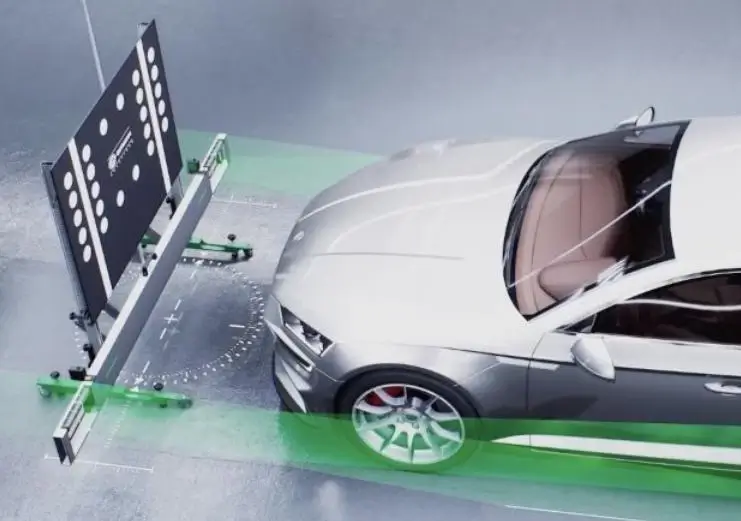How important is windshield calibration after a glass replacement
The Importance of Windshield Calibration for ADAS Systems
Advanced Driver Assistance Systems (ADAS) rely on a complex network of sensors, cameras, and radar systems to provide you with safety and convenience features like:
Adaptive cruise control
Lane departure warning
Automatic emergency braking
Lane centering and more.
However, these systems are highly sensitive and require precise calibration to function properly in everyday driving especially so in emergency accident avoidance situations. That’s why it’s so that the shop that replaces your windshield must perform ADAS calibration after the new windshield is placed. The Role of ADAS in Modern Vehicles
What’s involved in an ADAS calibration after a windshield replacement?
An ADAS calibration involves aligning the vehicle with a visual target and using a scan tool procedure to re-configure the sensors, cameras, and radar systems to ensure they accurately perceive the vehicle’s environment. Calibration is a meticulous process that requires precision and expertise, as even minor errors can lead to false readings and can compromise the system’s functionality.
Diagnostic Scan: A diagnostic scan is performed to assess the status of the ADAS system and identify any error codes or issues that may exist prior to the calibration. This step is crucial to understand if any recalibration is required.
Dynamic Calibration: Depending on the year, make and model, a dynamic calibration involves driving the vehicle in specific conditions to allow the ADAS systems to recalibrate themselves based on real-time data. This process is effective for certain systems like adaptive cruise control.
Static Calibration: For systems like lane departure warning, the vehicle is parked in a controlled environment, and calibration targets are positioned precisely to simulate real-world conditions. Cameras and sensors are then adjusted to align with these targets.
Specialized Equipment: ADAS calibration requires specialized tools and equipment to ensure accuracy. These tools help technicians make precise adjustments and verify calibration success.

A static calibration must be performed on a level floor with the vehicle located perfectly perpendicular to the visual target.
Why a windshield replacement requires a calibration even if the cameras weren’t moved
The optical clarity, thickness and curve conformity play a critical role in the accuracy of cameras that operate from inside the vehicle. Even if the installer thinks they didn’t jostle or move the camera, the new glass windshield demands a fresh calibration. Here’s why
1) No matter what the installer thinks he or she did or didn’t do to the camera during the windshield removal/replacement process, there’s no way to actually confirm there was no camera movement unless the technician performs a calibration.
In fact, when a windshield is replaced, there is a very high likelihood that the camera and sensors’ positions may have been altered or the alignment disrupted. Even factors such as the type of window adhesive used, the pressure used to place the glass into the bed of adhesive, and even the temperature of the adhesives and the vehicle sensors’ calibration.
Hacks don’t hack it
Some installers skip the calibration process because of an early belief that slipping a thin piece of cardboard between the cabin camera and the windshield will maintain the proper gap between the camera and the glass. It doesn’t, and this is a dangerous hack. As noted above, any difference in adhesive types, thickness, and pressure can change that gap without the installer’s knowledge. A calibration is the only way to ensure the camera is in the proper position. Without a calibration, the camera’s accuracy simply can’t be trusted.
What does windshield glass/camera, sensor calibration affect?
Automatic emergency braking
AEB is directly affected by the ADAS system’s ability to properly judge the closing speed and distance between the vehicle and an obstacle. In the more advanced systems, ADAS can even differentiate between people and vehicles, but only if the system is properly calibrated. Mis-calibration caused by a windshield replacement can result in false AEB activation or activation that is too late or too late to prevent an accident.
Lane departure and Automatic lane centering
Both of these systems relay on the camera and sensors ability to see and recognize lane markings and accurately calculate vehicle-to-lane marking distances. Any change in the windshield glass clarity, shape, or curvature can change the system’s ability to alert you or keep your vehicle in its lane.
What happens when ADAS isn’t calibrated after a windshield replacement?
In addition to the issues listed above, an out-of-calibration ADAS system can exhibit odd/random/non-repeatable behavior or false alarms. Many times these systems can’t be duplicated in a shop’s test drive, making repair very difficult.
For example, a lane departure warning system might activate even when the vehicle is safely within its lane. Such scenarios not only undermine your confidence in the technology but also increase the risk of distraction and loss of focus.
You incur a legal liability if you don’t calibrate your ADAS system after a windshield replacement
Glass shops that encourage you to skip the calibration will usually have you sign a waiver stating that you won’t hold the shop responsible if the ADAS system doesn’t perform as designed. That failure to calibrate can expose you to legal liability if your vehicle is even in an accident that could have been avoided had the ADAS system been properly calibrated. By signing that waiver, you relieve the shop of any responsibility for not properly calibrating the system. So the shops that encourage you to skip the calibration do so because they want to be off-the-hook.
You could lose some insurance discounts and even coverage
If you were granted an auto insurance discount for ADAS features, those policies usually state that the discounts and coverage are contingent upon you keeping the systems in working order, including a calibration after glass repairs.
Failure to perform post-windshield replacement calibration could potentially void coverage related to ADAS functionalities.
For all these reasons, you should always get a full calibration after any windshield replacement or repair.
©, 2023 Rick Muscoplat
Posted on by Rick Muscoplat
